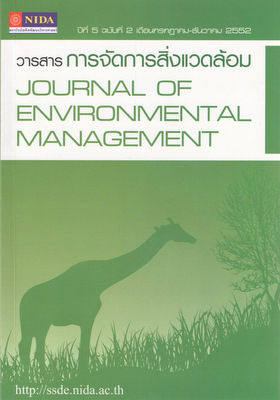ความเป็นไปได้ในการใช้ผักเบี้ยทะเล(Sesuvium portulacastrum) บำบัดดินเค็ม/The Possibility of Using Sesuvium portulacastrum in Saline Soils Treatment
บทคัดย่อ
การศึกษาครั้งนี้มีวัตถุประสงค์เพื่อศึกษาระดับความเค็มสูงสุดที่ ผักเบี้ยทะเลสามารถบำบัดได้อย่างมีประสิทธิภาพ รวมทั้งความสัมพันธ์ของอัตราการเจริญเติบโต ของผักเบี้ยทะเลกับความสามารถในการบำบัดความเค็ม และความเป็นไปได้ของการนำผักเบี้ย ทะเลที่ปลูกในดินเค็มไปเป็นอาหารของมนุษย์ในการศึกษาได้วางแผนการทดลองแบบ สุ่มสมบูรณ์ โดยผักเบี้ยทะเลนำมาจากโครงการศึกษาวิจัยและพัฒนาสิ่งแวดล้อมแหลมผักเบี้ย อันเนื่องมาจาก พระราชดำริ ตำบลแหลมผักเบี้ย อำเภอบ้านแหลม จังหวัดเพชรบุรี นำมาปลูก โดยเตรียมดินที่ระดับความเค็ม 0, 4 , 8, 12, 16 และ 20 เดซิซีเมนต์ต่อเมตร เก็บตัวอย่างเพื่อนำไป วิเคราะห์ 6 ระยะ คือ 0, 15, 30, 45, 60, 75 และ 90 วัน ผลการศึกษา พบว่าผักเบี้ยทะเลสามารถนำมาบำบัดดินเค็มได้โดยส่งผลให้ปริมาณโซเดียม ในดินลดลงภายหลังการทดลอง และเพิ่มขึ้นตามระดับความเค็มของดินที่ใช้ในการปลูกอย่างมีนัยสำคัญทางสถิติ ในขณะเดียวกันปริมาณโซเดียมที่สะสมในผักเบี้ยทะเลก็มีปริมาณเพิ่มมากขึ้น อย่างมีนัยสำคัญทางสถิติเช่นกัน สำหรับอัตราการเจริญเติบโตของผักเบี้ยทะเล พบว่าผักเบี้ยทะเล ที่ปลูกในดินที่มีความเค็ม 4.00 เดซิเมนต์ต่อเมตร มีอัตราการเจิญเติบโตดีกว่าในหน่วยการทดลอง อื่น ขณะที่มีแนวโน้มการเจริญเติบโตลงลงเมื่อความเค็มเพิ่มขึ้นอย่างมีนัยสำคัญ ทางสถิติ ในส่วนของสารอาหาร พบว่าปริมาณของโปรตีน ไขมัน และคาร์โบไฮเดรตขึ้นอยู่กับระดับความเค็มของดินที่ใช้ในการปลูกอย่างมีนัย สำคัญทางสถิติ
The main objective of this research was to find out the highest level in soil salinity treatment using Sesuvium portulacastrum. Correlation of growth rate of S. portulacastrum and soil salinity treatment, and possibility of using S. portulacastrum as a dietary after soil salinity treatment were also studied. S. portulacastrum were taken from the Laemphakbia Projects initiated by His Majesty King Bhumibol Adulyadej, Tambon Laemphakbia, Amphoe Ban Laem, Phetchaburi Province. The experimental plan was a completely randomized design, divided into 6 treatments (soil salinity levels at 0, 4, 8, 12,16 and 20 dS/m), with 28 replications for each treatment. Samples were taken for analysis at 0, 15, 30, 45, 60, 75, and 90 days.The results showed that the salinity soils could be treated by S. portulacastrum. NaCl in soil were decreased after experiment and tended to increase with increasing the soil salinity levels. In the same way, NaCl accumulation in plants was increased with increasing the soil salinity levels. For growth rate, the salinity of 4 dS/m in soil was the optimum level when compared with other treatments, and tended to decrease with increasing soil salinity levels. Plant nutrients in terms of protein, fat and carbohydrate were affected by soil salinity levels.


